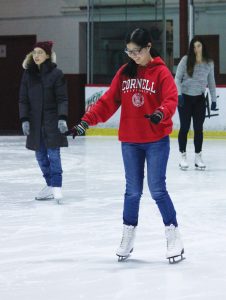
An intro to figure skating class.Lisa Banlaki Frank
“All right!” says veteran physical education instructor Linda McKeown, raising her voice to be heard above the pop music echoing through Lynah Rink. “Let me see your best skating! No toe pushing!” It’s a Wednesday in late January, and McKeown is teaching some two dozen students the basics of on-ice locomotion. Since this is the fourth class of the semester, most of them have the hang of it by now: they glide and shuffle in a slow oval, some more tentatively than others. “I feel like figure skating is a very East Coast thing,” Rebecca Restrepo ’19, an ILR major from Albuquerque, says as she does a steady loop around the rink. “In New Mexico you don’t really get snow or ice, so I thought it would be nice to embrace the cold this winter. It’s good.” Then she adds: “It’s cold.”
The following morning in Bartels Hall, a row of bow-wielding students takes aim at a line of bull’s-eye targets. The colorful circles, each fifteen yards away, are dotted with balloons that the students have inflated and pinned up. When they loose their arrows, a few hit the mark with a satisfying pop; many others go astray, striking the gray fiberglass curtain along the wall. “Archery is the coolest PE class that’s offered at Cornell,” says engineering student Thomas Taffe ’21. “It’s not something you get to do every day, but here you have the opportunity. It’s an awesome way to satisfy your PE credit.”
Archery is, in fact, one of roughly 300 awesome ways that Cornell students can earn physical education credit on the Hill—home to a large, vibrant, wildly varied program. Today’s undergrads have to take two PE courses to graduate (though playing on a varsity or JV team qualifies), making Cornell one of three Ivies, along with Dartmouth and Columbia, that have mandatory physical education. “If you go back a few thousand years, you have the idea of ‘sound mind and sound body,’ ” says associate director of physical education Fred Debruyn ’76, a Cornell PE staffer for four decades. “It’s hard to be on top of your mental capacity if you’re not in good shape. We’ve become more sedentary in this country over the last fifty years; today’s kids need to do some kind of physical activity, because most of them are so used to being on their computer, phone, PlayStation, or Xbox. We’re always looking for new activities that will attract students—and hopefully give them some stress reduction.”
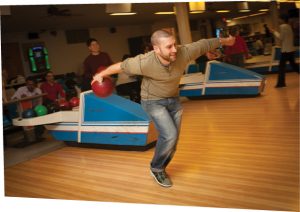
A recent bowling class in Helen Newman.Jason Koski/UREL
At Cornell, students can choose from a menu that ranges from the cardio-intense (boot camp, kickboxing, trail running) to the calming (stress management, birding, walking meditation). They can pick up skills to last a lifetime—from freshwater angling to ballroom dancing, juggling to self-defense, backcountry photography to Swedish massage. They can—like Taffe with archery—pursue pastimes they might not easily access later in life: circus arts, riflery, water skiing, gymnastics, boxing, caving, and much more. Want to learn bowling? Helen Newman is hosting fifteen sections of the intro class this spring, teaching 600 students. Most courses meet a few times a week throughout the semester, while others can be completed over a weekend or weeklong break. And then there are the off-campus offerings: students can go scuba diving in the Bahamas, tree climbing in California, sea kayaking in the Thousand Islands, canoe camping in the Adirondacks. “It’s a huge variety,” says Jen Gudaz, Cornell’s director of physical education and recreation. “Students have their choice of almost any activity they want to learn.”
Gudaz’s job has her overseeing most everything on campus that involves exercise without competition—including PE classes, Cornell Outdoor Education (COE), the swim test, intramurals, campus fitness centers, and the wellness program for faculty and staff. (Varsity and JV athletics are in another category; so are club sports, in which student-run teams practice and compete, often against their counterparts at other schools.) Gudaz notes that interest in physical activity is on the rise according to just about all measures—from student enrollment in PE classes to card swipes at the fitness centers to the use of the Bartels Hall climbing wall, which saw a tripling of participation after an $850,000 renovation and expansion in 2016. “It’s packed all the time,” she says of the wall. “We could build another one the same size and keep it going.”
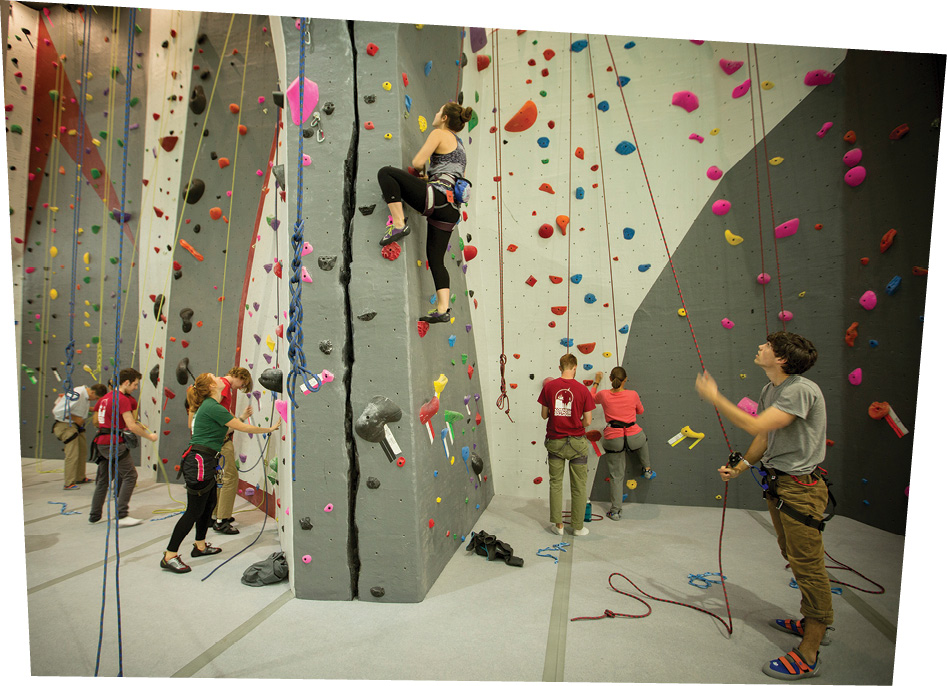
The newly renovated climbing wall in Bartels Hall.Jason Koski/UREL
In 2016–17, according to numbers from Gudaz, roughly 11,700 students were enrolled in PE classes, 11,000 had fitness center memberships, 3,800 did intramural sports, and 5,000 took classes or participated in activities through COE. And, she points out, many students who have already satisfied their PE credit requirement keep taking courses just for the love of it—700 of them last fall alone. Talia Burns ’19, who’s learning figure skating under McKeown this semester, has already taken intro to ice hockey (“My freshman year I wanted to take this class, but I couldn’t get in, so I thought hockey was the next best thing,” she says. “It’s really not.”) as well as racquetball, ballroom dance, and rock climbing. “I think college is a great time to keep physically active and try out new things,” says Burns, an Atlanta native who’s majoring in astronomy in Arts & Sciences. “If I was in the adult world, I probably wouldn’t have done any of those classes. I know some people complain and want to do the easiest thing possible, but I think it’s an opportunity.”
As Elaine Engst, MS ’72, the University’s archivist emerita, notes, physical education at Cornell goes back to its founding. In fact, when Andrew Dickson White produced his 1866 Report on the Committee on Organization—a comprehensive outline for the new institution that helped earn him its inaugural presidency—he stressed the importance of what was then known as “physical culture.” “Many plans of education have given goodly place to Physical Culture in theory; very few have given any adequate place to it in practice. No mistake could be more unfortunate. Better the mere rudiments of knowledge with a body sound, firm, and strong, than the best culture of the schools with a body permanently emaciated and debilitated… We cannot insist upon this part of an education too strongly.” White went on to suggest seven requirements, including a mandatory course in anatomy, physiology, and hygiene; facilities for playing baseball and for boating on Cayuga Lake; and a well-equipped gym, complete with an instructor “who shall conduct exercises… with as much regularity and under as stringent rules regarding attendance and decorum, as are observed in any college exercise whatever.”
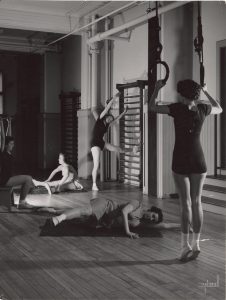
Working out in the Sage College gym in the Fifties.RMC
Women’s physical education also has a vibrant history at Cornell, dating back to the 1875 construction of Sage College, which included a gymnasium. In her memoir It Happened This Way, Ellen Coit Brown Elliott 1882 recalls the scene in Sage gym: “There, twice a week, the girls took off their corsets, or were supposed to, put on an ankle-length, full, lined, gray flannel skirt and a blouse waist, and did wand drill sedately round and round the hall. The advanced pupils had dumbbells.” The gym even featured a small swimming pool. “To circumnavigate that ten- by fifteen-foot area was no easy feat for a beginner,” Dorothy Bateman, the longtime head of women’s PE, recalls in Good Sports: A History of Cornell Athletics. “One alumna who had learned to swim there reported that when later displaying her newly acquired skill in a lake she discovered she could swim only in circles.” The University Register for 1914–15 lists a required course in physical training for women, held “daily except Saturday,” and required of freshmen and sophomores, as well as classes in advanced and corrective gymnastics. (Men had courses in physical exercise, as well as instruction in boxing, wrestling, and fencing.)[amazon_link asins=’0963327402′ template=’Sidebar’ store=’cornalummaga-20′ marketplace=’US’ link_id=’f3e654cf-1e2d-11e8-bd73-ff04a8713d8c’]
Physical education and recreational sports offerings on campus have been expanding ever since—but they’ve exploded over the past few decades. Al Gantert, who came to campus as an assistant swimming coach in the late Sixties and retired as PE director in 2009, recalls that when he arrived, “the curriculum did not venture far beyond what you’d think of as traditional physical education programming—basketball, volleyball, tennis, swimming. Very basic stuff.” But by the mid-Eighties, he says, the program had grown to include about 160 classes a semester, including offerings from COE, which had been established in the mid-Seventies. “Over the years, I stretched the bounds of physical education as far as I could, tuning in to what students wanted and needed; we got into courses that I would call self-help, like yoga, conscious living, and meditation,” says Gantert. “Students come out of the high school physical education programs—which generally are not very good—and get to Cornell, and go, ‘Oh my God, I have to take more? I thought I was free of that stuff!’ So I wanted students to look at what was available and not be turned off—and to this day, I think it’s pretty well received.”
Each semester, the PE curriculum includes about fifty-five classes run by COE, which also offers a variety of other activities—from equipment rentals to a pre-freshman program that draws about 200 students annually to team-building events for MBA students. One of the largest programs of its kind in the nation, it covers everything from ice climbing to paddling, day hiking to geocaching, wilderness first aid to back-country cooking. In 2016, COE was named the Program of Excellence by the Association of Outdoor Recreation and Education. “Cornell has some of the most intense academic individuals anywhere, and they would probably spend their whole lives driving hard into their textbooks and never look out the window, let alone walk across one of the most beautiful campuses—and that would be a significant loss to them as full individuals,” says director Marc Magnus-Sharpe. “Students who participate in COE programming get to focus intensely in another experience, one that engages all the neurons. With rock climbing, for example, you’re doing problem-solving on a set of holds as you work your way up.”
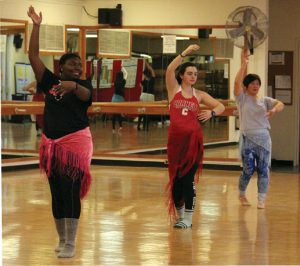
A belly dancing class in Helen Newman this semester.Lisa Banlaki Frank
Many of Cornell’s PE instructors have been with the University for years, even decades; McKeown, for instance, has been teaching figure skating on the Hill for more than a quarter-century. A couple of hours after the archery class on a Thursday in early February, June Seaney—who’s in her twenty-third year as a Cornell PE teacher—leads a belly dancing session in a Helen Newman studio. While the room has mirrors along three walls, she has her students face the windows overlooking Beebe Lake; it’s only the second class of the semester, and she doesn’t want them to feel self-conscious. She and her students—all women, though the class is also open to men—sport colorful, shiny scarves tied around their hips; Seaney’s is embellished with dozens of tiny metal disks that percuss as she dances. “Let’s shimmy!” she exclaims. “You’re never going to walk to class the same way again!”
Different Strokes
A freshman’s first exam: the swim test
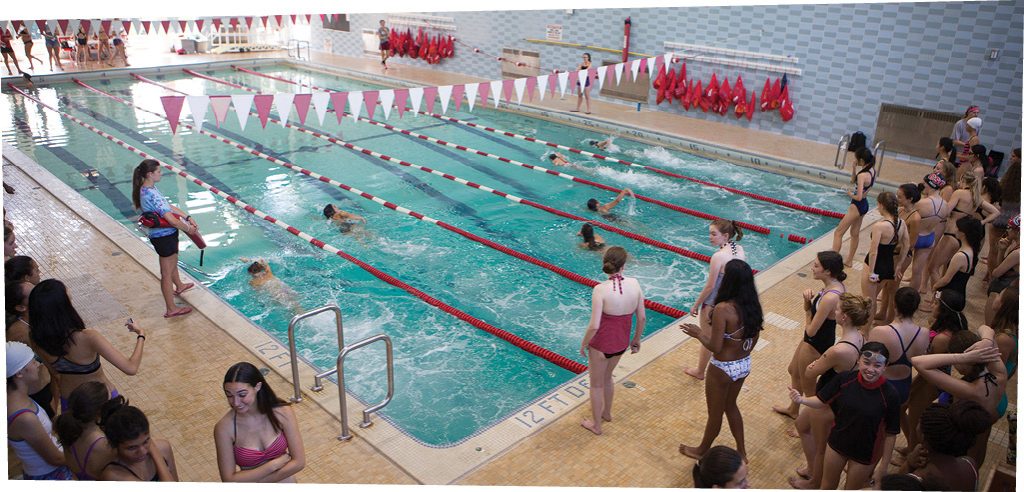
Lindsay France/UREL
It’s a rite of passage for almost everyone who spends four undergrad years on the Hill: the swim test. Cornell is one of about fifteen American universities that require students to demonstrate basic aquatic acumen to earn a bachelor’s degree (though transfer students are exempt). Only two other Ivies, Columbia and Dartmouth, still have the test, as does MIT.
According to Fred Debruyn ’76, who has taught aquatics and overseen the swim test on the Hill for four decades, the requirement traces its roots to the turn of the last century. “The swim test came about [in 1905], when Frank Barton was commandant of cadets,” Debruyn explains. “At that point, male students had to pass military drill to graduate. Barton said that it had been proven in modern warfare that a soldier who can’t swim is deadwood to his unit—so no one would pass drill unless they could complete a swimming test.”
The women’s test dates to 1920, when it was created at the behest of Dorothy Bateman, who served as director of women’s PE until the early Sixties. “She thought swimming was a necessary skill for educated young ladies,” says retired PE director Al Gantert. Back then, women took the test in the small pool in Sage College. “Basically, it was a little tank,” Debruyn says. “The test was to jump in and swim four circuits of the pool, about eighty yards. You were supposed to ‘jump in the water and come up smiling.’ ” By the early Seventies—for reasons that aren’t clear—women had to swim 100 yards, men only fifty. (Back then, Debruyn says, the men’s test—and all male open swims—was done naked, lest swimsuits fray and clog the filter.) In 1975, the requirements were standardized so all students had to swim seventy-five yards.
According to Debruyn, out of each freshman class of about 3,000, more than 90 percent pass the test their first semester. Most of the others take intro swimming—and then pass. However, he says, every year some students procrastinate until they’re about to graduate—either because they never got around to it or because they genuinely dread the water. Michelle Tu ’18, a human ecology student, is in the former category. “I guess I just didn’t feel like it?” she muses. “I’ll probably take it toward the end of the semester. I can swim already—it’s just something that I have to complete. And swimming is a good skill to have, so I think it’s cool that Cornell has that requirement.”
Every year, Debruyn says, a small number of seniors—“usually anywhere between eight and seventeen”—have not passed by graduation and can’t receive a diploma. Among the most memorable cases: an ’87 alum who came back to take the test two decades after graduation. Then there was the student who learned on the Tuesday of senior week that he wouldn’t get his diploma—and initially shrugged it off. “On Wednesday afternoon, he called me and said, ‘I need to pass the swim test.’ And I said, ‘Why? What changed?’ ” Debruyn recalls. “He said, ‘Two things. First, my parents are going to kill me.’ And he had been accepted to law school and they basically told him, ‘If you don’t have a diploma, don’t bother coming.’ ” Debruyn gave the senior private lessons over the next two days—and he passed. “I was extraordinarily impressed,” he says. “But you know—if he’d put in a little time in the previous four years, he wouldn’t have had that much stress.”
Sweatin’ to the Oldies
Remembrances of phys ed adventures
CAM asked alumni to share their PE memories. Here’s a sampling of responses:
“I remember the swim test. I showed up at the pool and was stunned to hear we’d have to swim the length. Even worse was that I hadn’t brought a bathing suit. ‘No problem,’ said the coach. ‘Do it naked.’ Of course I obeyed—the one drawback being that I quickly got tired and had to resort to the only stroke I could sustain for any length of time: the backstroke, all the way across the pool, naked, in front of an amused audience. I decided then and there my sport would be marching band.”
— David Ross ’73
“I took golf the spring of sophomore year. I had to play a certain number of rounds to complete the requirement, and sometimes I went to the course alone and was put in a threesome or foursome with other students. Two or three times, my playing partners were members of the men’s hockey team. They were all good golfers—much better than me. I remember standing there in amazement watching them hit these long drives off the tee. A golf swing is a lot like a slap shot—and boy, did these guys know how to drive the ball. And I think they got some laughs watching me hack away.”
— Jim Roberts ’71
“Participating in the Big Red Band, a significant time commitment, counted for a semester’s PE credit. I played clarinet. The organization has plenty of goofy traditions and spirit, and many fine musicians. I recall a Star Wars-themed show—current then, and probably still current now!”
— Steve Barre ’81
“In fall 1962, all freshman women had to take either modern dance or one of two lesser-ability classes. You were tested and assigned accordingly. My roommate, who was very nearsighted, removed her glasses to do the test, couldn’t judge where she was going as she skipped across the Risley dance studio, and hit the wall. She got the bottom-level class, even though she could do better in real life.”
— Susan Rockford Bittker ’66
“My husband, Chris Deane ’83, and I started dating October of freshman year. We decided to take ballroom dancing second semester, but at the end of winter break I broke up with him because our relationship had gotten serious too quickly. We were still dancing every Wednesday in PE—even when other guys came to pick me up at the end of class. After two months, I approached Chris about getting back together. It may never have happened if we weren’t forced to dance together that semester. This year is not only our 35th Reunion but our 35th anniversary—in part because of that ballroom dance class.”
— Barb Warner Deane ’83
“I have fond memories of participating on many intramural teams (football, soccer, box lacrosse, and hockey). We were not very good, but there was tremendous camaraderie and we had a great time. Hockey was played in the middle of the night at Lynah, but no one complained. Box lacrosse was a bit scary. The games were also at Lynah, when there was no ice, on a concrete surface with very little padding. I remember just being glad to survive without major injury.”
— Doug Skalka ’82
“We had to take survival swimming as a part of our Navy classes. I really enjoyed swimming two lengths with ankle weights on each foot. I recall things like towing a guy the length of the pool with a hand under his chin, and diving for things on the bottom.”
— Alan Newhouse ’59, BEE ’60
“I took skiing at Greek Peak. On my first run, a fellow skier asked the instructor, ‘Where should I aim?’ The instructor told him he would figure it out. Wearing new jeans, I went first. I traveled maybe twenty feet, fell, and rolled down. Flat on my back, I looked up the hill and saw a long blue line where my jeans had run. The instructor turned to the group and said, ‘You want to know what line to follow? Follow that blue line.’ And they did.”
— Mitch Frank ’75



I remember that swimming test. I passed with no problem, but a couple of my friends (or perhaps I should say future friends, because we hadn’t yet met at the very beginning of our freshman year) who were from New York City and didn’t have access to swimming pools and such growing up wound up in basic swimming. And I remember that warning at orientation that to graduate from Cornell, you have to take phys ed, that’s all there was to it. Unless you were a veteran, in ROTC, on a team, or disabled. And we too were told about that handful of seniors every year who spent the summer making it up because they didn’t and therefore couldn’t get their diplomas until they did. I took judo my 1st semester and scuba diving my second semester freshman year, and in those days you had to take two years of phys ed so I took riflery my first semester sophomore year and skeet and trap shooting my second semester. There was a small fee for those courses, but I’ll admit that I’m not much of an athlete and wasn’t that good at and didn’t really enjoy more conventional sports, so I figured why not make the best of it and take something I probably wouldn’t do otherwise and might enjoy. And I did enjoy it. In fact it was a welcome relief from the rather tedious required academic courses of my freshman year. In hindsight I’d recommend to any freshman to resist (to a degree) getting EVERY required course out of the way all at once and take something you’re sure you’d enjoy taking.
My most embarrassing memory: indoor golf. It was set up inside a barn-like space, with target bedsheets hung at one end and we amateurs at the other. I would take my stance, line up all my parts, address the ball — and miss the sheet. Never did get the hang of it, and I’ve thought it best not to try playing on a real golf course!
I loved the many P.E. options offered and every physical activity imaginable. I took at least one, sometimes two, every semester. By far, I enjoyed my Junior fall semester when I enrolled in Equitation at the Center on Pine Road. It was my first time on a horse and one of the most memorable experiences of my Cornell undergrad.
When Helen Newman Hall opened my sophomore year, I took as much bowling as I could. However, the highlight (lowpoint?) of that year was taking fencing the first time it was offered. Our instructor was the assistant coach of the fencing team, but he did not speak English, so the coach translated for him. Instead of picking up a foil and getting to slash around with it, we spent most of the 50 minute class on the floor doing exercise to strengthen our abs and legs, and only the last ten minutes or so, going “avance, avance, lunge!” However, the class produced the first participants on the Cornell women’s fencing team. I can assure everyone that I was not one of them!
I took swimming for three semesters. That’s how long it took me to pass the basic swim requirement. I can’t say I enjoyed myself. It was the hardest course I had to take while at CU. The instructor was great. Seems like I was with a bunch of hockey players and black fellows. Mostly low body fat and floated like a ton of bricks.
I don’t even remember what the first class was that I tried at Helen Newman, mostly because I dropped it as soon as it became clear that I could not make it all the way there from other classes on campus and back in the time allotted. I then tried ice skating, since that class was held at Lynah, more centrally located on campus. That worked ok, but it was a pain to carry my ice skates around all day when I had phys ed. I finally settled on skiing at Greek Peak as the best recourse to satisfying the phys ed requirement. It was a wonderful experience and a skill I continued to enjoy for many years. I learned to ski under some of the worst possible snow conditions and it made me a better skier.
Modern dance, Martha Graham technique, required of Freshman women. Liked it enough to take an extra semester. Bowling at a down-at-the-heels bowling alley in College Town. Riding, with Cornell’s retired Army horses who really just wanted to stay retired. Mine bit me when I tried to put on the bridle. Lots of choices even then. I also tried golf, but decided I didn’t need golf clubs to walk around outdoors.
__ Marion Malcolm (Chute) ’61
LOVED my PE classes, and took one just about every semester! Ice skating, spelunking, white water kayaking, gymnastics. Also enjoyed intramural sports w/KD. Good times!
Horseback riding was my choice. Had to walk from Clara Dickson to the barn. Little did I realize, when I signed up that as part of the lesson I would also have to groom the horse too.
Then I chose fencing, then modern dance, then I almost signed up for bell ringing in the tower (at least I thought it was an athletic endeavor to walk up all those steps). In recent years I’ve some tap and other dancing in “senior” shows and go as far as I can on not so long walks and leave it at that.
I took skiing at Greek Peak for 2 Spring semesters. It cost about $65 for six sessions, which included transportation, rental skis, lift ticket and a 90-minute lesson. What a life-changing deal for a poor college student! I still love to ski. Recently I paid double that for a one-day lift ticket.
I graduated from Cornell in 1974. I remember the PE classes. The first semester I took riflery and proudly sent my targets home to show my Dad. After that, every semester I took figure skating. I was born and raised in South Florida and had never seen ice before arriving at Cornell!
I took indoor golf one quarter. It was only for a few weeks, the shortest possible commitment.
I took horseback riding 7 out of 8 semesters. Great class unfortunately no longer an option! Very sad!
Agreed! Hopefully someday it will return – I was a student instructor at Oxley and was very disappointed when the program closed the year after I graduated. Ironic how such a popular program for so many decades was scrapped without a second thought as to its legacy among Cornellians.
I dreaded having to take Phys Ed for two semesters, and still remember having to take the swimming test during one of my first days in Ithaca. But I decided to make the most of the situation, and enrolled in Ballroom Dancing in the fall semester, and Downhill Skiing at Greek Peak for the spring semester. Skiing in upstate New York was at times icy, cold, and windy, and now (living in Seattle), I’m far more likely to ski at Western resorts than to go back East. But I shared a lift chair last weekend at Mount Bachelor in Oregon, with a gentleman who had lived in Cortland many years back and skied at Greek Peak! That was the first time in many years I’ve met anyone who had even heard of Greek Peak.
To pass, we had to spend at least 16 hours windsurfing on the water, in 1989 or 1990, but I had only done 13 by the first weekend of November, the last weekend of the season; so I put on my wetsuit and went out in the season’s first snowstorm.
I learned to ski as a freshman at Greek Peak thanks to the Cornell PE requirement. I loved it and repeated the course sophomore year but had an awkward fall and tore the miniscus in my knee, ending my season, but not my phys ed requirement. A physician in the on-campus clinic recommended some resistance exercises to rehabilitate my knee, so I switched to weightlifting to gain access to the equipment. I met some great jocks there, who taught me some techniques. By the end of the spring semester, my knee was much stronger and I had an upper body for the first time in my life. I still do light resistance training today – a lifelong habit encouraged by my alma mater.
I barely passed the swim test because I went too fast on my first lap and tired myself out. If I remember correctly, at the time, we had to do 25 yards on our stomachs, 25 on our backs, then the last 25 with whatever stroke we preferred. I managed the final length of the pool on my back, and the tester told me I passed but recommended that I take basic swimming anyway. As a horse-crazy girl from New York City, I had my heart set on horseback riding, though, and signed up for that. I loved learning to care for the horses, saddling up, trotting and cantering, and taking basic jumps. I fell off once when my mount refused a jump but thankfully walked away with nothing worse than overall achiness. Later on, I volunteered with a 4-H program at the Cornell stables helping disabled kids to ride. I also took archery, fencing, and figure skating (I got just good enough that once, at the Rockefeller Center rink, a young girl, overly impressed by my spirals and half loop jumps, asked me if I was Kristi Yamaguchi). I wish that I’d taken PE every semester; it was such a fun, fulfilling part of the Cornell experience. (My roommate had to take basic swimming twice before she managed to pass the test; I don’t think she took any other PE classes. She missed out.)
I took two sessions of bowling at Eddy Street Lanes where we had to take turns setting the pins.
We found this image in the Cornell Rare and Manuscript Collection while researching the story — does it bring back memories?
Although we only needed two semesters of Phys Ed, I was so impressed by the courses offered that I took four (all of which were co-ed). Where else but Cornell could I take scuba diving, horseback riding, ice hockey, and advanced lifesaving? I was in the Big Red Band (and Pep Band) too, but by that time it didn’t count toward phys ed credit.
I was a transfer student so I didn’t have to take PE. I tried to sign up for scuba diving but underclassmen had priority so I couldn’t get in. (I took it later as an adult ed class elsewhere). I would have passed the swim test easily. I would have liked to take figure skating too but I already knew how to skate.
In the Spring of 1990, I took cross country skiing and, once the snow thawed, sailing. Loved both classes!
I took two semesters of karate, one of judo and one of disco dancing. I also partnered with someone who did a semester of ballroom dancing. Passed the swim test.
I took riflery with my apartment-mate Jeff K. I was not very good. In fact, I was pretty lousy. So, I devised a new tactic. I started shooting at Jeff’s target. He never did figure out why he did so poorly–luckily for me, he never actually counted the holes in his target. If he should read this today, I’m sure he’ll have a good chuckle.
I started PE as a freshman but promptly came down with mononucleosis and spent two weeks in Sage Hospital. Back at Teagle, they said I couldn’t rejoin PE that semester. So I joined the Fencing Team and they counted it.
I do not recall being given a choice as to which sports to try, and we all did wrestling, water polo, golf, squash and maybe something else. The most incredibly exhausting sport is water polo, in the deep end where there are nothing but thrashing bodies, swimming over you, fighting for the ball, and constantly treading water. That was the closest I have ever come to drowning when I was taking in a deep breath and someone shoved me under. Already short of breath, my competitive spirit died and all I could do was make it to the edge of the pool and literally hang on for dear life. When watching water polo in the Olympics I never forget that panic, and I just marvel at the strength and skill of the big bruising Olympians.
I was “on the field hockey team” in pre-Title IX days when the team consisted of whoever signed up for field hockey as an early-fall PE class. We played games against Ithaca College, SUNY Cortland, Elmira, Wells, and William Smith. We wore our regular PE uniform of white short-sleeved blouse with a round collar, navy blue shorts, and sneakers–no red!. Some of our players were actually talented. Sadly I was not among them.
I was never the athletic type so I took bowling at the Eddy Street Lanes (before automatic pin setters), tennis, and canoeing on Beebe Lake where I came dangerously close to the waterfall! I have no idea why I never had to take a swim test to graduate but am glad I got away without doing it.
Swim-test was not an issue growing up body-surfing in the California Pacific Ocean since I was about 5 years old. We actually had a pool & swim test freshman year at my high school freshman year. I took a semester of horseback riding & learned to ride Eastern style! Then there was skiing at Greek Peak, to cool for school! Good memories for sure.
As a life long learner, I take the brain and the body to both be subjects that need constant improvement and challenges. I have taken on Triathlons at 50 and learned how to swim way better. I love all three sports now. I completed 6 half IronMan events up till last year when I completed my first full Ironman 140.6 mile event November 3rd in Florida in 11 hours 43 minutes. When we look at the problem with how few people really like to push their bodies, I am certain that the PE requirement is more important today than ever before. Im going back this year to try and improve 1:15 over last year.
If you could pass a number of tests that included running a mile (I don’t remember the time limit but it is the only time I ever ran a mile, coming in completely exhausted just under the cut off time), plus a certain number of chin ups, sit ups and push ups. If you completed all the tests, you had several choices, one of which was to be assigned one of the quarter horses from the Cornell polo team that was not being used that year. We learned to groom the horse, apply and remove the bit/halter and saddle and could then ride whenever we wished on the extensive campus trails. There were riding lessons as well. I had already had several hours of self taught riding experience before I entered Cornell but having your own horse for a term, was the most fantastic experience. I would bring an apple or some carrots, both of which the horse loved. I did not have to urge him to run. He wanted to run, and run we did. An exhilarating experience for both of us.
I took four PE classes back in the late ’70s. My first PE class was judo, but after waking up at 7 am to have my body thrown around for an hour before I even had breakfast, I decided ice skating would be more fun. So I took 2 ice skating classes. My final PE class was skiing. They bussed us out to Greek Peak. We had a lot of snow that year so it was great, except for the below-zero wind chill!
Fall semester of my freshman year I took backpacking, which culminated in a weekend trip. I still remember waking up the second morning with the tarp under which we were sleeping just inches from my face, due to the weight of the snow that had fallen overnight. When we arrived back on campus no one believed we had been snowed on because it was a lovely and warm October day there! Second semester I decided to stay indoors and took bowling at Helen Newman. In retrospect, I wish I had taken more PE classes.